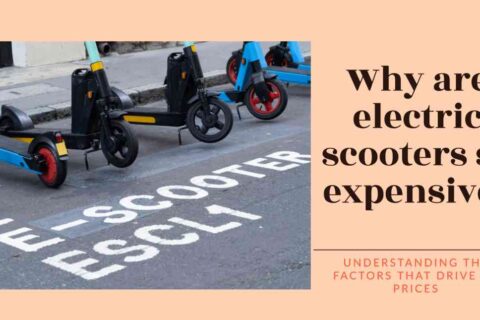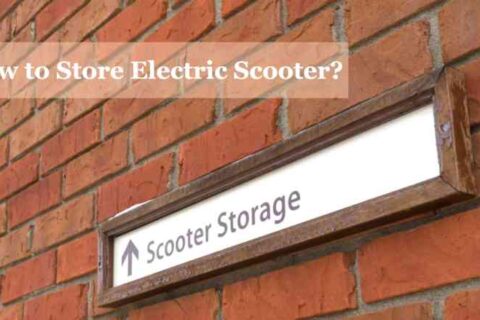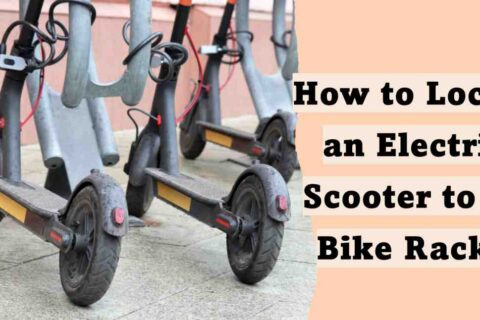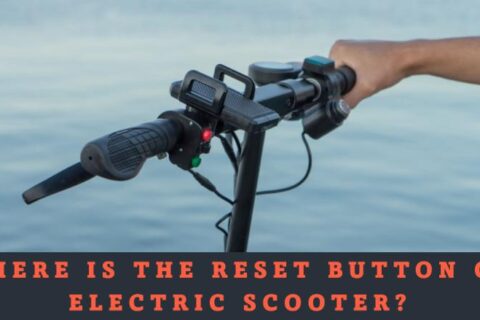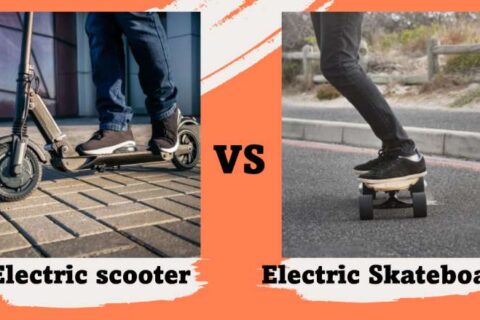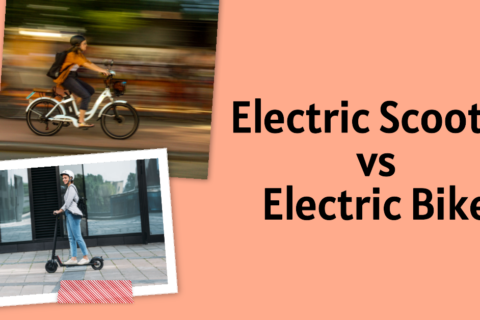Whether you are a new electric scooter owner or considering purchasing one, understanding how long electric scooter batteries last and the factors that affect their lifespan is crucial for making informed decisions and optimizing your scooter’s performance.
This article will explore the average lifespan of electric scooter batteries and discuss the factors that can influence their longevity.
By understanding these factors, electric scooter owners can make informed decisions about their battery usage, maintenance, and potential replacement, ensuring optimal performance and a prolonged lifespan for their scooters.

Photo Credit: Trend Max
Table of Contents
ToggleHow long do Electric scooter batteries last
Electric scooters have gained popularity as a sustainable mode of transportation, and understanding the lifespan of electric scooter batteries is crucial.
On average, electric scooter batteries can last between 1 to 3 years, equivalent to approximately 300 to 500 full charge cycles. These cycles correspond to a range of 3,000 to 10,000 miles traveled on an electric scooter before the battery performance starts to decline.
Higher-quality batteries have the potential to reach up to 1,000 cycles, extending the lifespan. It is important to note that battery wear is better measured in charge cycles rather than specific time frames.
Charging the battery from around half-full to full (50% to 100%) is more typical for most users. In this case, you can expect to perform approximately 600-1000 charge cycles over the battery’s lifespan.
Charging patterns vary among users, but if you charge your scooter every day, the battery can last between 1 and 2 years. However, it’s more common for people to charge their scooters once every 2 or 3 days. Based on this estimate, the battery can last at least 2 years and potentially up to 5 years.
Also Read: Electric Scooter Batteries – Everything You Want To Know
Factors Affecting Electric Scooter Battery Life
Usage patterns:
The frequency and duration of scooter rides can affect the battery life. Heavy or prolonged use can lead to faster battery depletion.
Terrain:
The terrain you ride your electric scooter on can affect its battery life. Riding on flat and smooth surfaces typically conserves more battery power, allowing for longer rides.
However, uphill climbs, rough and uneven terrains, and stop-and-go traffic can increase power consumption, resulting in shorter battery life. It’s important to consider the terrain you’ll be riding on to manage your battery usage and plan your rides accordingly.
Rider weight:
Heavier riders or riding with heavy weight can reduce the battery life of an electric scooter due to increased strain on the motor and higher power consumption.
Speed:
High speeds on an electric scooter consume more battery power, leading to faster battery drain. Riding at lower speeds helps conserve battery life, extending the scooter’s range.
Temperature:
Extreme temperatures, both hot and cold, can impact the performance and lifespan of the battery. It’s best to avoid exposing the scooter to extreme temperature conditions.
Charging practices:
Overcharging the battery or leaving it completely discharged for extended periods can degrade its performance and shorten its lifespan. Following proper charging practices is essential.
Maintenance:
Regular maintenance, such as keeping the scooter clean, checking tire pressure, and ensuring proper electrical connections, can contribute to the overall health and longevity of the battery.
Environmental Factors:
The environment where you use and store your electric scooter can impact the battery’s lifespan. Extreme temperatures can affect the battery’s performance and longevity. Avoid exposing your scooter to direct sunlight for extended periods or leaving it in extremely hot or freezing conditions.
It is advisable to allow your battery to cool down for a period of at least 15-20 minutes before initiating the charging process.
Understanding Battery Degradation
Battery degradation is a natural process that occurs over time and affects the capacity and performance of electric scooter batteries.
Charge Cycles:
The number of charge cycles a battery undergoes is a primary factor in battery degradation. As the number of cycles increases, the battery’s capacity gradually diminishes. Regular usage and frequent charging can accelerate the degradation process.
Temperature:
The temperature has a significant impact on battery degradation. Exposure to high temperatures speeds up the degradation process, while extremely low temperatures can temporarily reduce battery performance. Maintaining moderate operating and storage temperatures helps preserve battery health.
Depth of Discharge (DOD):
Deep discharges, where the battery is drained to very low levels, can accelerate capacity loss. It is advisable to avoid fully discharging the battery and recharging it before it reaches critically low levels.
Charging Habits:
Charging practices can affect battery degradation. Overcharging, leaving the battery connected to the charger for extended periods, or charging in extreme temperatures can degrade the battery. Using the recommended charger and adhering to manufacturer guidelines for charging can help mitigate these issues.
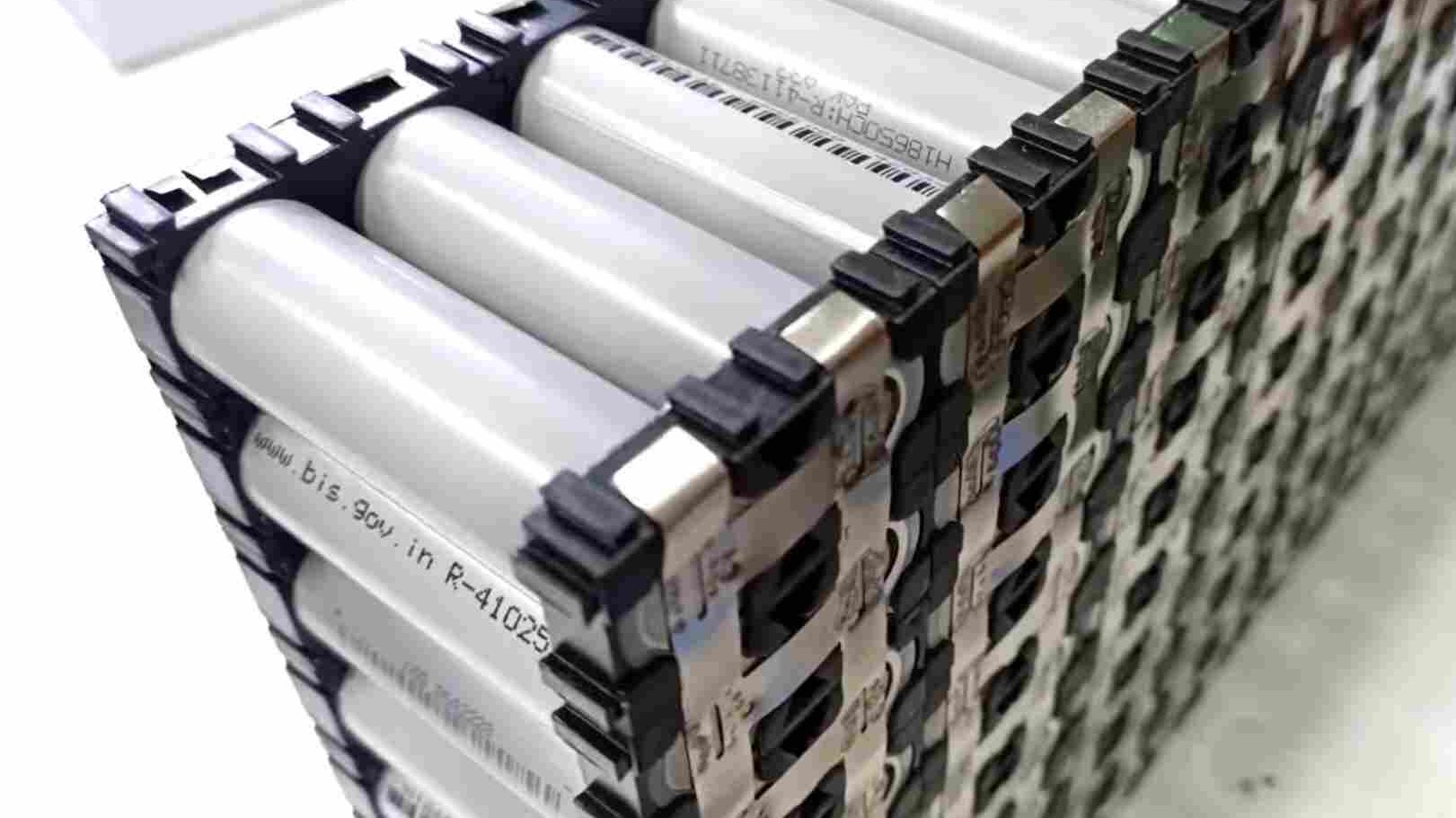
5 Maximizing Tips for Electric Scooter Battery Life
A well-maintained battery not only ensures optimal performance but also extends the range of your electric scooter. In this article, we will provide you with valuable tips and best practices to prolong the lifespan of your electric scooter battery, covering aspects such as battery selection, charging practices, and avoiding deep discharges.
I. Battery Selection: Choosing a High-Quality Battery
One of the key factors in prolonging your electric scooter battery lifespan is selecting a high-quality battery with suitable capacity and energy density. Here are a few considerations when choosing a battery:
- Trusted Brands: Opt for batteries from reputable manufacturers known for their quality and reliability. These brands often prioritize battery performance and longevity.
- Capacity and Energy Density: Choose a battery with sufficient capacity to meet your daily commuting needs. Higher energy density batteries can provide longer rides on a single charge, minimizing the strain on the battery and potentially extending its lifespan.
II. Proper Charging Practices: Guidelines for Maximizing Battery Lifespan
Charging your electric scooter battery correctly is crucial for its longevity. Follow these best practices:
- Avoid Overcharging: Overcharging can lead to unnecessary stress on the battery and shorten its lifespan. Always unplug the charger once the battery is fully charged, and avoid leaving it connected to the charger for extended periods.
- Use the Recommended Charger: Each electric scooter comes with a specific charger designed for its battery. Using a different charger can result in improper charging currents, potentially damaging the battery. Stick to the manufacturer-recommended charger for optimal charging performance.
- Charge at Room Temperature: Charging the battery at moderate temperatures (around 20-25 degrees Celsius or 68-77 degrees Fahrenheit) is ideal.
- Avoid Deep Discharges: It’s best to avoid completely draining the battery before recharging. Regularly recharge your electric scooter battery when it reaches around 20-30% capacity remaining. Deep discharges can strain the battery and accelerate degradation.
III. Maintenance and Care
Following a few simple best practices, you can maximize the lifespan of your battery and enjoy a reliable and efficient ride.
Regularly Clean Battery Terminals:
- Gather the necessary supplies: You will need a soft cloth or sponge, warm water, and mild detergent.
- Disconnect the battery: Before cleaning, ensure that your scooter is turned off and the battery is disconnected from the power source.
- Clean the terminals: Dip the cloth or sponge in warm water mixed with a small amount of mild detergent. Gently scrub the battery terminals to remove any dirt or corrosion. Be careful not to use excessive force that could damage the terminals.
- Rinse and dry: After cleaning, rinse the terminals with clean water to remove any residue. Ensure the terminals are completely dry before reconnecting the battery.

Inspect for Signs of Damage:
Regular inspections are crucial to identify any signs of damage or wear on your electric scooter battery. Here are some key aspects to consider during your inspections:
- Physical damage: Look for any visible cracks, dents, or bulges on the battery casing. Such damage could compromise the battery’s integrity and safety.
- Leaks or corrosion: Check for any leaks or signs of corrosion around the battery terminals. Leaks or corrosion can indicate a faulty battery that may need to be replaced.
- Loose connections: Ensure that all the battery connections are secure and tight. Loose connections can lead to electrical problems and affect the battery’s performance.
Proper Storage During Non-Use Periods:
If you plan to store your electric scooter for an extended period, proper storage practices are essential to maintain the battery’s health. Follow these guidelines:
- Charge the battery: Before storing, ensure the battery is adequately charged. A charge level of around 50% is recommended for long-term storage.
- Choose an appropriate location: Find a cool, dry place to store your scooter and battery. Avoid areas with extreme temperatures or high humidity, as these conditions can accelerate battery degradation.
- Disconnect the battery: If possible, disconnect the battery from the scooter during storage. This prevents any unintentional drain or power loss.
IV. Avoid Exposure to Extreme Temperatures:
Temperature has a significant impact on the lifespan of an electric scooter battery, yet many riders underestimate its importance when it comes to proper care.
- Avoid excessive heat: High temperatures can cause the battery to overheat, leading to capacity loss and reduced lifespan. If possible, park your scooter in shaded areas or use a cover to shield it from direct sunlight.
- Protect from the extreme cold: Extremely cold temperatures can affect the battery’s chemical reactions and reduce its capacity temporarily. If riding in cold weather, keep the battery warm by insulating it or using battery covers designed for insulation.

Photo Credit: Trend Max
V. Optimal Riding Habits
When it comes to getting the most out of your electric scooter battery, it’s not just about the type of battery or proper maintenance.
- Avoid Rapid Accelerations and Abrupt Braking:
Sudden bursts of acceleration and hard braking not only waste energy but also put additional strain on the battery.
- Maintain a Steady Speed:
Maintaining a steady speed while riding your electric scooter can significantly improve battery efficiency.
Constant speed helps the scooter operate at its most efficient level, minimizing energy wastage. Avoid unnecessary fluctuations in speed and try to maintain a consistent pace when riding.
By doing so, you can maximize the distance covered per charge and extend the battery life.
- Plan Efficient Routes with Less Incline:
The terrain you choose to ride on can have a significant impact on your scooter’s battery life. When planning your routes, opt for paths with less incline whenever possible.
Uphill climbs require more power from the battery, draining it faster. By selecting routes with fewer inclines, you can reduce the energy demand on the battery and extend its range.
- Utilize Eco Mode When Available:
Many electric scooters come equipped with an eco mode, which adjusts the scooter’s performance settings to prioritize energy efficiency. By activating the eco mode, you can limit the scooter’s top speed and optimize its power consumption.
This mode is particularly useful for daily commuting or leisurely rides where speed is not the primary concern. Utilizing eco mode can help you conserve battery power and increase the overall range of your scooter.
Adopting a smooth and gradual acceleration pattern can increase the life of the electric scooter
Battery Replacement and Cost
Over time, the battery of your electric scooter may start to show signs of degradation, affecting its performance and range.
Signs Indicating the Need for Battery Replacement:
Decreased Range:
One of the most apparent signs that your electric scooter battery may need replacement is a significant decrease in range. If you notice that your scooter’s battery no longer holds a charge for as long as it used to or if the range has significantly reduced, it may be time to consider replacing the battery.
Sluggish Performance:
As batteries age, they may struggle to deliver sufficient power, resulting in sluggish performance. If you notice a lack of acceleration, reduced top speed, or the scooter feels less responsive than before, it could be an indication that the battery is nearing the end of its lifespan.
Increased Charging Time:
If your electric scooter battery takes significantly longer to charge than it did when it was new, it may be a sign that the battery’s capacity has diminished. Extended charging times can inconvenience your daily routine and indicate that a battery replacement might be necessary.
When you see the signs of battery deterioration, opting for an electric scooter battery replacement is crucial. Ensuring safe and worry-free rides provides peace of mind and a secure riding experience.
Read More: Best Guide to Electric Scooter Battery Replacement
Factors Affecting the Cost of Electric Scooter Battery Replacement:
Battery Type and Capacity:
The cost of replacing an electric scooter battery can vary depending on the type and capacity of the battery. Lithium-ion batteries, which are commonly used in electric scooters, tend to be more expensive than other battery types but offer better performance and longer lifespans.

Brand and Quality:
The brand and quality of the battery can also influence the cost of replacement. Established brands with a reputation for quality and reliability may have higher-priced replacement batteries. Segway-Ninebot, Razor, Mighty Max, Vici are some of the popular scooter brands with reasonable price points.
However, investing in a reputable brand ensures you are getting a battery that meets safety standards and provides optimal performance.
Compatibility:
Electric scooter batteries are not universally compatible across different models and brands. Finding a replacement battery that is compatible with your specific scooter model can affect the cost. It’s crucial to ensure that the replacement battery is a suitable match for your scooter to ensure proper fitment and performance.
Warranty Coverage:
Some electric scooter manufacturers offer warranty coverage for the battery. If your scooter is still under warranty and the battery is experiencing issues, you may be eligible for a free or discounted replacement. Check the warranty terms and conditions to understand your coverage and potential cost savings.
Final Words:
Regular maintenance and care are essential for ensuring the longevity of electric scooter batteries. This includes regularly cleaning the battery terminals, inspecting for any signs of damage or wear, properly storing the scooter and battery during periods of non-use, and avoiding exposure to extreme temperatures.
If you ride your scooter every day and charge it accordingly, the battery may last between 1 and 3 years. However, it isn’t the only answer for how long do Electric scooter batteries last, if you ride less frequently and charge the battery every second or third day, it can potentially last longer, exceeding 2 years and possibly doubling that timeframe with proper care.
By following the provided tips and guidelines for optimal battery care and usage, electric scooter owners can enjoy extended battery life, improved performance, and a reliable riding experience. It is important to remember that proper battery care not only benefits the scooter owner but also contributes to the overall sustainability and longevity of the electric scooter industry.
Frequently Asked Questions:
Can electric scooter last 10 years?
Yes, If it is well-built, properly maintained, and used under suitable conditions, which is ideally very challenging. However, certain components, such as the battery, may need replacement or upgrade during this period of time.
What is the battery life of Xiaomi scooter?
Xiaomi scooter battery life can vary depending on the specific model and usage conditions. Generally, Xiaomi electric scooters are equipped with lithium-ion batteries that offer a range of approximately 15 to 30 kilometers (9 to 18 miles) on a single charge.
How often do you need to replace the battery in an electric scooter?
Electric scooter battery life depends on the life cycle, although in normal scenario, batteries last for 1 to 3 years depending on usees pattern. So it can be estimated around 2 to 3 years battery needs to be replaced.
How much does a new battery for a scooter cost?
Generally, electric scooter battery prices range from $100 to $500, with premium batteries reaching up to $1,200.
Lithium-ion batteries are commonly used in electric scooters, priced between $100 and $300 depending on size and brand.



